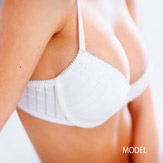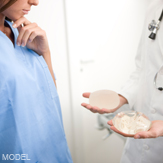Archive for the ‘Breast Implant’ Category
Sientra® Breast Implants Demystified
Although the Sientra form-stable breast implants are a new product for many board-certified plastic surgeons, I have been offering women in Los Angeles this breast implant option for years. I was one of a handful of surgeons chosen to participate in the clinical trials for these remarkable implants. Through my research, I have found that Sientra implants offer women many advantages – primarily, that they are made from a high-strength gel that is extremely durable and leak-resistant. These implants are the originals – the ones I nicknamed “gummy bears” because the semi-solid gel is similar that of a gummy bear candy: the implant can be cut in half and still retain its shape.
This video shows how remarkably cohesive the new Sientra implants are. Even when the gel is displaced under pressure, it retains its shape and does not leak.
Understanding the Original Gummy Bears
There are many misconceptions about gummy bear breast implants and about breast implants in general. If you are considering breast augmentation, it’s important that you speak with a knowledgeable surgeon so that you have all the information you need to make the best choice for you.
Gummy Bear Implants Do:
- Have a low complication rate comparable to other silicone gel implants
- Have a lower incidence of capsular contracture
- Have a decreased incidence of rippling/wrinkling
- Come in several shapes and styles, including round
Gummy Bear Implants Do Not:
- Require larger incisions
- Feel firmer than other implants
- Necessarily cost more
- Leak or ooze if ruptured
Breast Implants: A Brief History
Breast implants in Los Angeles and across the nation have been popular for years, but they have undergone many transformations. The results are improvements in safety, quality and appearance that my female patients love. One particularly exciting new advancement is the “gummy bear” implant, a silicone-gel implant with a texture similar to that of gummy bear candies. It provides an even more natural look and feel than earlier silicone implants.
Here’s a brief history of just how far breast implants have advanced in terms of safety and quality:
- In 1961, researchers created the first silicone breast implants at Dow Corning. These first-generation implants were much more likely to leak than the ones we offer today.
- In 1968, the first saline implants were created. The drawback to these early versions was their fragile casings, which could result in deflation. Also, a “sloshing” noise could sometimes be heard.
- Silicone implants have gradually gone through a series of improvements, with stronger cover materials and denser, more cohesive gel fillers. Complication rates decreased dramatically, while the quality and appearance of the implants soared.
- Despite these improvements, in 1992, the FDA banned silicone implants for everyone except reconstruction and revision patients. As a result, saline implants were used for more than 90% of surgeries.
- In 2006, the FDA gave its approval to silicone implants for women age 22 and older. Women 18 and older can have saline implants.
- In 2012, Sientra® gummy bear breast implants are approved. Additional crosslinking between the silicone molecules allows these implants to retain their shape, especially in the vertical position.
Silicone implants have continued to advance, with the latest generation called “gummy bear” implants. The gel material is both firm and soft, just like gummy bear candy. It can be pushed, pulled and even cut without dramatically changing its shape. Initial studies show that these new implants are even more effective and safer than earlier ones.
I take pride in the fact that my partner, Dr. Michelle Spring, and I are among a small group of surgeons chosen to use these new silicone breast implants in Los Angeles as part of a clinical study. I look forward to even more innovations in our ongoing effort to provide the best for our patients.
Common Breast Augmentation Concerns
Although women in Los Angeles find breast augmentation to be a highly effective procedure, there are usually some questions stemming from rumors they’ve heard from friends or things they’ve read on the Internet. Here are some common breast augmentation concerns I’ve encountered, followed by the facts about this popular procedure:
Concern: Following breast augmentation, it is difficult or impossible to breastfeed or to maintain nipple sensation.
Fact: Although there is a slight chance that you may lose nipple sensation or will be unable to breastfeed, most of my patients experience no complications following surgery. Choosing an experienced and well-trained surgeon is a good way to minimize risks associated with procedures. Also, many patients who lose nipple sensation after breast augmentation find that it returns after a time.
Concern: Breast implants are dangerous and cause negative health consequences.
Fact: There are a number of breast implant options that can increase the safety of this procedure. Saline implants are filled with a sterile saltwater solution that is naturally absorbed by the body should a leak occur. Silicone implant technology has greatly improved, and the cohesive gel used in today’s implants does not leak or migrate in the case of rupture. Additionally, having regular check-ups can help you maintain your implants and your overall health.
Concern: What is capsular contracture, and how can it affect my surgery?
Fact: Capsular contracture refers to the accumulation of hardened scar tissue around implants. I take great precautions in reducing the chance for this and other complications, and I work diligently to minimize negative influences on your surgery or recovery. Less than 3% of our patients have a capsular contracture.
These are just a few of the concerns women have regarding breast augmentation. I recommend speaking to a qualified surgeon to discuss your specific questions. Typically, choosing a well-trained and experienced surgeon can minimize your chance of risk and improve your surgical experience and outcome.
Breast Implant Basics
There are a number of options to consider when women decide to have breast augmentation. At my practice in Los Angeles, breast implant discussions, such as silicone versus saline, typically are the focus of breast augmentation consultations. Here are some of the basics to help you know more about this topic:
- Silicone implants are filled with a cohesive elastic gel that many say feels more like natural breast tissue.
- Women can typically choose from three incision locations for inserting the implants: under the breast along the natural crease (inframammary incision), under the armpit (transaxillary incision), and around the areola (periarolar incision).
- Breast implants can be placed under the pectoral muscle, or between the pectoral muscle and breast tissue. This decision is best made with a qualified surgeon, and is often based on a number of factors, including implant type and cosmetic goals.
By understanding the available options and talking with an experienced surgeon, you can achieve your goals more successfully.
Why the Breast Implant Pocket is Crucial
Women considering breast enlargement in Los Angeles often ask about where their breast implants will be placed. There are two possible locations: subglandular (over the pectoralis muscle) or submuscular (underneath the pectoralis muscle). The decision depends on several factors.
The breast implant pocket is the space in which the implant will be placed. In my experience, most women tend to choose to have their breast implants placed underneath the muscle. By choosing that location, I can provide them with a more natural appearance, because it reduces any rippling. In addition, placing the implant pocket submuscularly reduces the risk of complications such as capsular contracture, symmastia, and what’s known as “bottoming out.”
Other benefits of placing the implant pocket subglandularly include a quicker and more comfortable recovery, as well as keeping the muscles in place. However, it is important to understand your own body frame and related considerations all need to be considered in the ultimate decision. By placing the breast implant pocket in the ideal location for you, I can ensure a comfortable recovery and beautiful results.
Breast Implants and ALCL
In the last few days I have received questions from several patients who heard about the U.S. Food & Drug Administration’s recent guidance regarding a possible connection between breast implants and anaplastic large cell lymphoma (ALCL). Both for women who have implants and those who are considering a breast augmentation procedure, I would like to provide more information about this guidance and suggest some next steps.
What the FDA Is Doing
An initial review by the FDA has identified 34 unique cases of ALCL in women with breast implants throughout the world. To put this in perspective, it is estimated that 5 to 10 million women worldwide have breast implants. The FDA believes that women with breast implants may have a very small but increased risk of developing this disease, and is asking health care professionals to report confirmed cases of ALCL in women with breast implants to the FDA.
What the FDA Is Not Doing
The FDA is not taking back its approval of saline and silicone gel breast implants. To quote the organization: “The FDA believes that the totality of evidence continues to support a reasonable assurance that FDA-approved breast implants are safe and effective when used as labeled.”
What You Need to Know
If you have had breast augmentation, I advise you to continue to follow your doctor’s regular implant care instructions. Because ALCL is not a breast cancer, there is no benefit to performing additional self exams, but it is worth talking with your surgeon in more detail if you are particularly concerned, if only for added peace of mind.
For women who are thinking about breast augmentation, it is important to get the latest facts. Additional fact finding on this issue will be ongoing and informed surgeons will be able to give you the most current information while providing additional context for the scientific findings so far.
Silicone Implants and Breast Reconstruction
A recent study published in the online edition of the journal Cancer reported that breast reconstruction patients who chose silicone implants following their mastectomy were more satisfied than those who chose saline implants. Although saline implants have been continuously available for decades, the look and feel of silicone implants is now leading many women to choose silicone implants, both for cosmetic and reconstructive procedures.
It comes as no surprise to me that more and more women are choosing silicone implants in general; at Marina Plastic Surgery Associates, we’re participating in a Los Angeles breast implant clinical trial for the fifth generation of silicone implants, also known as “gummy bear” implants, and we are finding very high satisfaction rates with this implant type. We are also seeing high satisfaction with the silicone gel implant type widely available to women today.
For breast cancer reconstruction, silicone implants also make sense. Since most or all of the breast tissue can be removed during a mastectomy, many women not only want their breast to look how it used to look, but want it to feel just like their old breast as well. Coupled with the fact that gummy bear implants retain their shape when torn or punctured, how they feel makes silicone breast implants a great option.
This is not to say that silicone implants are good for every woman. There are several situations where saline implants can give the desired effect or even be preferable to silicone implants. Of course, this should be decided on a case-by-case basis with your surgeon.
Los Angeles Breast Implant Study Released
Even after silicone gel breast implants were approved by the FDA in 2006, surgeons across the country have been participating in trials of a newer “fifth generation” silicone gel breast implant, also referred to as a “form stable” or “gummy bear” breast implant. This latter nickname is derived from their texture– they are both soft and solid, resembling the texture of a gummy bear candy. If cut in half, the implant would retain its same form.
My colleagues and I have been participating in studies of form-stable cohesive breast implants and recently completed a review of the efficacy of this implant type. For our study we examined 355 Los Angeles breast implant patients over a 60-month period, which included women who had primary augmentation, primary reconstruction and revision breast surgery.
The results of our study concluded that these implants had similar complication profiles to other types of silicone gel breast implants. Our study also found that the fifth generation silicone implants have a lower rate of capsular contracture and a decreased incidence of wrinkling compared to fourth generation silicone gel implants, as well as other published studies of fifth generation silicone implants.
As of right now, fifth generation silicone implants are not cleared to be marketed by the U.S. Food and Drug Administration, meaning that they are only available to the women who have chosen to participate in the clinical trials. Our study may provide more information that will help this implant type become widely available in the years to come.
MRI Scans for Silicone Breast Implants
The generation of silicone gel implants currently available in the U.S. is highly advanced and widely researched. This latest generation is also highly durable, and unlike saline implants, when a rupture or tear to a silicone implant occurs, it may not be immediately noticeable to the patient. These so-called “silent ruptures” can be detected through periodic MRIs, which I advise for all of my Los Angeles silicone gel breast implant patients.
Because a rupture in silicone gel breast implants is hard to detect, patients need to take an active role in monitoring their implants. When a rupture occurs, the silicone gel contained within the implant tends to stay in the pocket (the space that surrounds the breast implant) and the outward appearance of the breast often does not change at all. The FDA recommends that patients have an MRI performed 3 years after their breast augmentation, and then every 2 years after that continuously.
Symptoms
While some women do not notice any change after a silicone breast implant rupture, patients may experience symptoms such as knots or lumps surrounding the implant, change in shape or size of the implant, swelling, pain, numbness, or hardening of the breast. Although these symptoms of a rupture are possible, they are not always present, which is why it is critical to have an MRI performed as recommended by the FDA.
Dr. Grant Stevens

I am a board-certified Beverly Hills plastic surgeon with over 20 years of experience researching and implementing new approaches to plastic surgery. At Plastic Surgery Insider, you get the benefit of my experience and authority when you read my perspectives on the latest news and procedures in plastic surgery.
More on my qualifications »

Popular Topics
Archives
- August 2013
- July 2013
- June 2013
- May 2013
- April 2013
- February 2013
- January 2013
- December 2012
- November 2012
- October 2012
- September 2012
- August 2012
- July 2012
- June 2012
- May 2012
- April 2012
- February 2012
- January 2012
- December 2011
- November 2011
- September 2011
- August 2011
- July 2011
- June 2011
- May 2011
- April 2011
- March 2011
- February 2011
- January 2011
- December 2010
- November 2010
- October 2010
- September 2010
- August 2010
- July 2010
- June 2010
- April 2010
- February 2010
- January 2010
- December 2009
- November 2009
- October 2009






